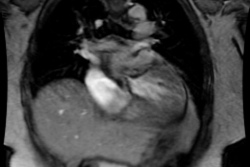J Am Coll Cardiol 1990 Mar 15;15(4):827-32
Quantification of coronary artery calcium using ultrafast computed tomography.
Agatston AS, Janowitz WR, Hildner FJ, Zusmer NR, Viamonte M Jr, Detrano R.
Ultrafast computed tomography was used to detect and quantify coronary artery
calcium levels in 584 subjects (mean age 48 +/- 10 years) with (n = 109) and
without (n = 475) clinical coronary artery disease. Fifty patients who underwent
fluoroscopy and ultrafast computed tomography were also evaluated. Twenty
contiguous 3 mm slices were obtained of the proximal coronary arteries. Total
calcium scores were calculated based on the number, areas and peak Hounsfield
computed tomographic numbers of the calcific lesions detected. In 88 subjects
scored by two readers independently, interobserver agreement was excellent with
identical total scores obtained in 70. Ultrafast computed tomography was more
sensitive than fluoroscopy, detecting coronary calcium in 90% versus 52% of
patients. There were significant differences (p less than 0.0001) in mean total
calcium scores for those with versus those without clinical coronary artery
disease by decade: 5 versus 132, age 30 to 39 years; 27 versus 291, age 40 to 49
years; 83 versus 462, age 50 to 59 years; and 187 versus 786, age 60 to 69
years. Sensitivity, specificity and predictive values for clinical coronary
artery disease were calculated for several total calcium scores in each decade.
For age groups 40 to 49 and 50 to 59 years, a total score of 50 resulted in a
sensitivity of 71% and 74% and a specificity of 91% and 70%, respectively. For
age group 60 to 69 years, a total score of 300 gave a sensitivity of 74% and a
specificity of 81%. The negative predictive value of a 0 score was 98%, 94% and
100% for age groups 40 to 49, 50 to 59 and 60 to 69 years, respectively.
Ultrafast computed tomography is an excellent tool for detecting and quantifying
coronary artery calcium.





